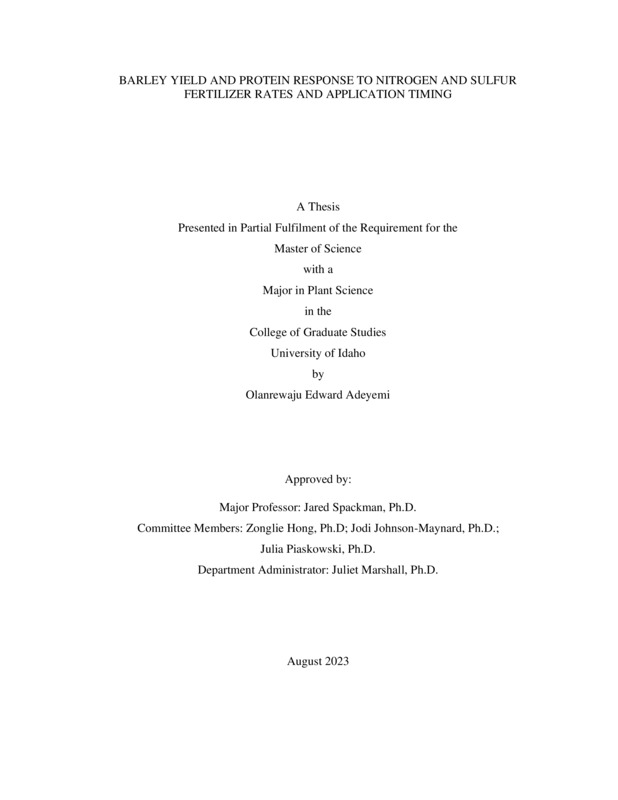BARLEY YIELD AND PROTEIN RESPONSE TO NITROGEN AND SULFUR FERTILIZER RATES AND APPLICATION TIMING
Adeyemi, Olanrewaju E. (2023-08). BARLEY YIELD AND PROTEIN RESPONSE TO NITROGEN AND SULFUR FERTILIZER RATES AND APPLICATION TIMING. Theses and Dissertations Collection, University of Idaho Library Digital Collections. https://www.lib.uidaho.edu/digital/etd/items/adeyemi_idaho_0089n_12712.html
- Title:
- BARLEY YIELD AND PROTEIN RESPONSE TO NITROGEN AND SULFUR FERTILIZER RATES AND APPLICATION TIMING
- Author:
- Adeyemi, Olanrewaju E
- ORCID:
- https://orcid.org/0000-0002-0313-2100
- Date:
- 2023-08
- Keywords:
- Barley yield and Protein Malt quality N use efficiency Nitrogen Sulfur
- Program:
- Plant Sciences
- Subject Category:
- Plant sciences
- Abstract:
-
The introduction of new barley varieties and changes in management practices necessitate re-evaluating nitrogen (N) and sulfur (S) nutrient management and application timing guidelines. Nitrogen has a significant impact on barley grain quality and yield. However, overapplication of N can result in yield reduction, groundwater pollution, and high protein content, resulting in lower end-use quality of barley, while underapplication of N results in reduced grain quality and yield. Because S improves N utilization and enhances protein synthesis and split N application improves yield and N use efficiency in winter barley, split N application timing and the interaction of N and S may be a valuable tool to reduce N loss, increase yield, improve grain quality, and improve N use efficiency for agronomically optimal spring barley production. In a bid to provide barley growers in the Western US with an optimal N application timing, as well as appropriate N and S rates for improved yields and grain quality and reduced input costs and environmental contamination, we evaluated the effects of N and S fertilizer rates and application timing on malt, feed, and food barley grain yield and quality for four site-years in Aberdeen and Kimberly Research and Extension Centers and Brigham Young University-Idaho in Idaho for the 2021 and 2022 growing seasons. Three barley varieties: malt (Moravian 179), feed (Claymore), and food (Julie) were grown at 1,980,000 seeds ha-1. Nitrogen fertilizer treatments included urea (46-0-0) applied at 0, 45, 90, 135, or 180 kg N ha-1 at planting or a split application of 45 kg N ha-1 done at planting and top-dressed with 23, 45, or 90 kg N ha-1 at heading. Sulfur fertilizer treatments included three S rates of potassium sulfate (0-0-53-18) fertilizer applied at 0, 17, or 34 kg S ha-1 at planting. Data was collected on grain yield, protein concentration, plant height, harvest heads, test weight, kernel plumpness, and N use efficiency.We investigated fertilizer rates for N and S, but S did not affect yield and yield components due to the high S concentration in the irrigation water. Plant height, harvest heads, and grain yield increased with increasing N rate for all varieties except at the Aberdeen 2021 field site, where grain yield was non-responsive to N due to the high preplant N at this location. The linear responses indicate N fertilizer insufficiency to maximize yield. Claymore had a quadratic response at Rexburg, with a maximum yield at approximately 120 kg N ha-1 rate. At the Aberdeen 2021 site, Julie responded to N and had a quadratic response with a maximum yield between 135-180 kg N ha-1. Grain protein concentration, test weight, and kernel plumpness were similar to those reported for Moravian 179, Claymore, and Julie in the southeastern and southcentral Idaho variety trials. Single N application produced similar or greater yields than split N application, contributing a 6-46% yield advantage over split N application across all varieties. Similarly, single N applications improved N use efficiency compared to split N applications and contributed a 9-25% N use efficiency advantage. For malt barley at Kimberly and Rexburg, split N application produced grains with 0.6-1.4% higher protein concentrations than acceptable for malting, suggesting an economic loss for growers as grains are sold as feed. This study demonstrated how pre-plant soil N content and N treatment timing affect spring barley yield and quality responses to N. Furthermore, we showed that the high S concentration in the irrigation water in this area negates the need for additional S fertilizer to maximize barley productivity and quality on the Snake River Plain. Split N applications are not an efficient way to increase yield, and N use efficiency for spring barley production and should be avoided in favor of a single N application at planting.
- Description:
- masters, M.S., Plant Sciences -- University of Idaho - College of Graduate Studies, 2023-08
- Major Professor:
- Spackman, Jared
- Committee:
- Hong, Zonglie; Piaskowski, Julia; Johnson-Maynard, Jodi; Marshall, Juliet
- Defense Date:
- 2023-08
- Identifier:
- Adeyemi_idaho_0089N_12712
- Type:
- Text
- Format Original:
- Format:
- application/pdf
- Rights:
- In Copyright - Educational Use Permitted. For more information, please contact University of Idaho Library Special Collections and Archives Department at libspec@uidaho.edu.
- Standardized Rights:
- http://rightsstatements.org/vocab/InC-EDU/1.0/

